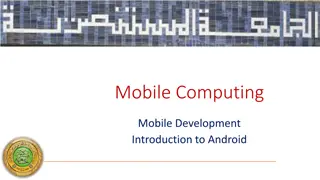Enhancing Enterprise Policy Enforcement on Android Devices
Smartphones are increasingly vital in the workplace, but managing Android devices for enterprise use presents challenges due to inadequate permission settings and legacy systems. Current research aims to customize systems for policy enforcement, despite the need for extensive modifications and lack of isolation between apps and management code.
Download Presentation

Please find below an Image/Link to download the presentation.
The content on the website is provided AS IS for your information and personal use only. It may not be sold, licensed, or shared on other websites without obtaining consent from the author. Download presentation by click this link. If you encounter any issues during the download, it is possible that the publisher has removed the file from their server.
E N D
Presentation Transcript
DeepDroid: Dynamically Enforcing Enterprise Policy on Android Devices Fall 2015 Instructor: Kun Sun, Ph.D.
Roadmap Introduction Overview DeepDroid-Permission DeepDroid-Behavior Evaluation Conclusion
Introduction Smartphones are increasingly adopted in workspace 51% of end users rely on smartphones to perform daily business activities. Cisco However, Android devices are not easily managed for system design Permission: Coarse and not configurable Device Administration API SEAndroid: legacy phones(85.8%<version 4.3), inadequate MAC in middleware
Current Status Device OEMs add their own management APIs Samsung SAFE & Knox HTC APIs 3LM APIs MDM vendors bustle about all these extended APIs
Current Research Customize system to enforce policies Require tremendous modification to source code Portability issue for Android branches and OEMs Rewrite Android apps Intercept security sensitive APIs from multiple layers Lack of isolation between App and management code
Roadmap Introduction Overview DeepDroid-Permission DeepDroid-Behavior Evaluation Conclusion
Overview centralized controller system_server for middleware permissions system_server client-server architecture system services, content providers, etc. com.android.phone /system/bin/mediaserver android.process.media Communication-Binder RPC to services/Callbacks Intent Content Providers Messengers Ashmem android.process.acore
Overview (cont.) Operations inside of process boundary Based on Linux system calls Comply with Linux DAC Create process that can: read/write sdcard access network use camera read contacts Activity Manager zygote Linux privilege authorized right after process creation setgroups/setresgid/setresuid app3 app2 app1
Our approach Dynamic memory instrumentation flexible permission system_server com.android.phone /system/bin/mediaserver android.process.media android.process.acore behavior extraction & enforcement
Our approach (cont.) System call tracking Tracking process creation for privilege authorization Tracking process operations zygote app3 app2 app1
Why our approach? Stable system architecture permission mechanism, system services, binder realization, etc. Reduce source code modification to configuration carry little burden on vendor customization Central management isolation transparent to apps
Roadmap Introduction Overview DeepDroid-Permission DeepDroid-Behavior Evaluation Conclusion
DeepDroid-Permission system_server is the core of permission mechanism. A few checking interfaces system_server Permission Check inter- process Monitoring Code Enterprise Policy Repository Key: Java method redirection
DeepDroid-Permission classes.dex byte code dalvik-LinearAlloc accessFlags Method insns interpretor nativeFunc native code libx.so
DeepDroid-Permission Some permissions (user groups) are checked in Kernel. system_server monitoring 3: reset groups & track until setuid 2: recognize app 1: launch request --runtime-init --setuid=10028 --setgid=10028 --setgroups=1015, 3003, 1006, 1007 android.app.ActivityThread app process zygote fork
Roadmap Introduction Overview DeepDroid-Permission DeepDroid-Behavior Evaluation Conclusion
DeepDroid-Behavior Interactions between apps and system services ioctl(binderFd, BINDER_WRITE_READ, &bwr) By tampering Global Offset Table (GOT) of libbinder.so system_server android.process.acore upper layers upper layers app access to services call-backs Intent ContentProviders Messenger ashmem libbinder.so libbinder.so Behavior Enforcement libc.so libc.so Binder driver
DeepDroid-Behavior Synchronous invocation E.g., getLastKnownLocation(), getDeviceId() system process pairwise within binder thread BR_TRANSACTION requests interfaces defined in aidl & in .java reflect on write buffer BC_REPLY return value
DeepDroid-Behavior Asynchronous invocation With oneway callback(e.g., onLocationChanged) system process counterpart recognization 1) servicemanager 2) IBinder instances get a remote handle reflect on write buffer BC_TRANSACTION callback value interfaces defined in aidl or in .java
DeepDroid-Behavior Parameter types IBinder: map remote handles to uid/pid ParcelFileDescriptor: shared memory (content provider, media, etc.) Parcelable: rebuild objects with built-in CREATOR
Roadmap Introduction Overview DeepDroid-Permission DeepDroid-Behavior Evaluation Conclusion
Tested Resources Resource Permission Group PEP1 Process IMEI package READ_PHONE_STATE com.android.phone Phone # package READ_PHONE_STATE location package system_server ACCESS_FINE_LOCATION contacts package android.process.acore READ_CONTACTS camera camera package/PCG2 mediaserver CAMERA account package system_server GET_ACCOUNTS logs log READ_LOGS PCG2 app process network inet package/PCG2 INTERNET SMS package com.android.phone SEND_SMS 1PEP: permission enforcement point 2PCG Process Creation Guard
Tested Devices Device Android OS Nexus S(Samsung) Android OS 2.3.6 Sony LT29i Android OS 4.1.2 Android OS 4.2.2 Android OS 4.0 Galaxy Nexus(Samsung) Samsung Galaxy Note II Android OS 4.1 Samsung Galaxy Note 3 Android OS 4.3 Nexus 5(LG) Android OS 4.4 Meizu MX II Flyme 3.2 (Android OS 4.2.1) Android OS 4.2 Huawei Honor 3c
Performance (cont.) Benchmark Scores Normal Quadrant Traced Quadrant Normal CaffeineMark Trace CaffeineMark MX II 2508.5 2507.6 6367.2 6207.5 LT29i 4653.8 4553.6 14125.5 13998.5 Nexus S 1750.0 1705.6 5982.8 5959.9
Roadmap Introduction Overview DeepDroid-Permission DeepDroid-Behavior Evaluation Conclusion
Conclusion We propose a framework to achieve a fine- grained control on Android resources. DeepDroid dynamically instruments and traces core processes of Android system. Based on stable structures across multiple OS versions, DeepDroid is easily ported. DeepDroid requires little firmware configuration rather than customizing Android source code.























